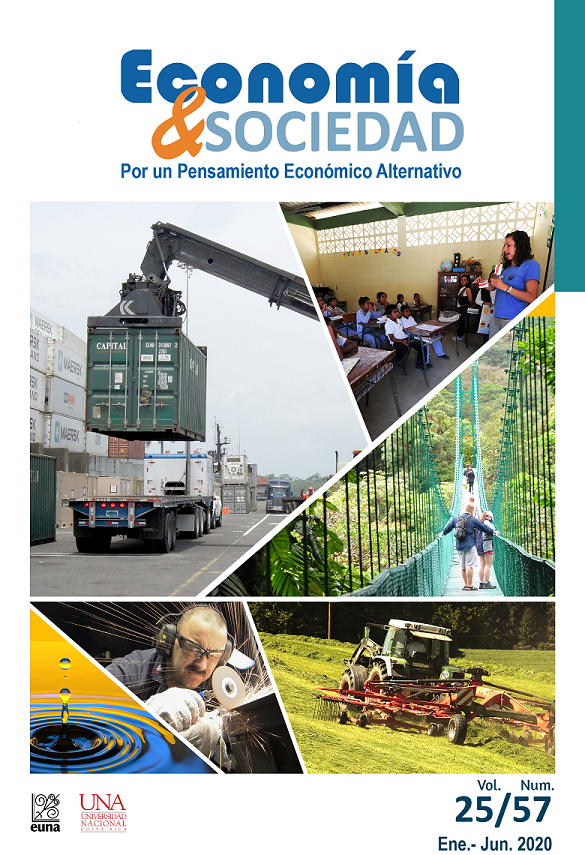Aglomerações industriais locais vis-à-vis redes competitivas globais: noções marshallianas de áreas econômicas, inovação e desenvolvimento territorial
DOI:
https://doi.org/10.15359/eys.25-57.3Resumo
A inovação é uma das principais contribuições que os clusters podem fazer para impulsionar o desenvolvimento regional e territorial. Esta revisão literária pós-marshalliana exaustiva compara e contrasta a noção de inovação e explica sua evolução no contexto de abordagens teóricas recentes que explicam as aglomerações industriais modernas e o desenvolvimento territorial.
Desde 1990, e até as contribuições teóricas mais recentes, este estudo analisa a inovação, principalmente em relação aos clusters, e como eles podem contribuir para o desenvolvimento e a competitividade daqueles em territórios e países. O modelo Diamond de Porter e suas extensões teóricas, focadas na demanda e determinantes de fatores e mercado, são catalisadores intelectuais da noção de inovação em relação ao desenvolvimento territorial. No entanto, este estudo denota que sua ambiguidade e flexibilidade levaram escritores franceses pós-Porterianos a considerar que espacialidade e relacionalidade através de redes, setores e indústrias são essenciais para gerar inovação e criação de conhecimento, e sua respectiva disseminação. Além disso, abordagens de economia política, como os modelos de inovação de hélices e a análise semiótica inspirada no marxismo, estimularam o uso da inovação como um fator de mudança, que influencia territórios e nações.
À medida que a inovação é incorporada aos modelos estudados, sua contribuição se torna cada vez mais evidente. O denominador comum entre todas as teorias pós-marshallianas é o papel crucial e mutante que a inovação desempenha como catalisador da competitividade e do desenvolvimento nas zonas francas e nos níveis territorial, nacional e global.
Referências
Becattini, G. (1986). Del “sector industrial” al “districte industrial”: algunes consideracions sobre la unitat de recerca de l’ economía industrial. Revista Económica de Catalunya, 1, 4-11. Retrieved from : https://www.coleconomistes.cat/Canales/Ficha.aspx?IdMenu=1e333773-ef9d-4d24-a878-86732e3a51dd&Cod=c9f879f8-41b8-4dbc-98c1-1b0b104bcf1a&Idioma=ca-ES
Becattini, G. (1992). Le district industriel, milieu créatif. Espace et Sociétés, 66(I), 147-164. Doi : https://doi.org/10.3917/esp.1992.66.0147
Carayannis, E. & Alexander, J. (2006). Glocalized Knowledge Structures through Transnational Public-Private Research and Technology Development Partnerships: Conclusions and Recommendations for Policies and Practices. Global and Local Knowledge. (First ed.). London: Palgrave Macmillan. Doi: https://doi.org/10.1057/9780230508729
Carayannis, E. & Campbell, D. (2009). ‘Mode 3’ and ‘Quadruple Helix’: toward a 21st century fractal innovation ecosystem. International Journal of Technology Management, 3/4(46), 201-234. Doi: https://doi.org/10.1504/IJTM.2009.023374
Carayannis, E., Barth, T. & Campbell, D. (2012). The Quintuple Helix innovation model: global warming as a challenge and driver for innovation. Journal of Innovation and Entrepreneurship, 2(1), 1-12. Doi: https://doi.org/10.1186/2192-5372-1-2
Carayannis, E. & Campbell, D.F.J. (2012). Mode 3 knowledge production in Quadruple Helix innovation systems. (First ed.). New York: Springer. Doi: https://doi.org/10.1007/978-1-4614-2062-0
Carayannis, E. & Grigoroudis, E. (2016). Quadruple Innovation Helix and smart specialization: Knowledge production and national competitiveness. Foresight and STI Governance, 1(10), 31-42. Doi: https://Doi.org/10.17323/1995-459x.2016.1.31.42
Cho, D. (1994). A dynamic approach to international competitiveness: the case of Korea. Asia Pacific Business Review, 1(1), 17-36. Doi: https://doi.org/10.1080/13602389400000002
Cho, T. & Mun, H. (2002). From Adam Smith To Michael Porter: Evolution of Competitiveness Theory. (Extended Edition). New York: World Scientific Publishing. Doi: https://doi.org/10.1142/8451
Cho, D., Moon, H. & Kim, M. (2006, Junio, 24). Competitive strategy to enhance national competitiveness. In Academy of International Business, Globalization and Competitiveness. Conference in Proceedings of the Academy of International Business 2006 Annual meeting, Beijing, China.
Depret, M. H. & Hamdouch, A. (2009). Clusters, réseaux d’innovation et dynamiques de proximité dans les secteurs high-tec. Une revue critique de la littérature récente. Revue d’économie industrielle, 128, 21-25. Doi: https://doi.org/10.4000/rei.4067
Dzisah, J. & Etzkowitz, H. (2011). The Age of Knowledge: The Dynamics of Universities, Knowledge and Society. Boston: Brill Publishers. Doi: https://doi.org/10.1163/ej.9789004211025.i-342
Etzkowitz, H. (2008). The triple helix: university-industry-government innovation in action. New York: Routledge.
Etzkowitz, H. (2010). University-industry-government: The triple helix model of innovation. Retrieved from: https://www.semanticscholar.org/paper/University-Industry-Government%3A-The-Triple-Helix-of-Etzkowitz/c7377b7a3c21d78caff9357560da79064ea197b5.
Giuliani, E. (2007). The selective nature of knowledge networks in clusters: evidence from the wine industry. Journal of Economic Geography, 2(7), 139-168. Doi: https://doi.org/10.1093/jeg/lbl014
Glaser, B., & Strauss, A. (1967). The Discovery of Grounded Theory: Strategies for Qualitative Research. (Primera ed.). United States Of America: Aldine Transaction. Retrieved from: http://www.sxf.uevora.pt/wp-content/uploads/2013/03/
Grandclément, A. (2016). Articuler approche relationnelle et approche spatiale des réseaux: application au cas de pôles de compétitivité. Géographie, économie et société, 4(18), 471-492. Doi: https://ges.revuesonline.com/article.jsp?articleId=37065
Huggins, R. & Izushi, H. (2011). Competition, Competitive Advantage, and Cluster: The Idea of Michael Porter. Oxford: Oxford University Press. Retrieved from: https://www.oxfordscholarship.com/view/10.1093/acprof:oso/9780199578030.001.0001/acprof-9780199578030-chapter-1
Jessop, B. (2006). Critical semiotic analysis and cultural political economy. Critical Discourses Studies, 2(1), 1-16. Doi: https://doi.org/10.1080/17405900410001674506
Jessop, B. (2005). Cultural Political Economy, the Knowledge-Based Economy, and the State. In Barry, A. & Slater, D. (Eds.). The Technological Economy. (First ed., 144-165) London: Routledge.
Markusen, A. (1996). Interaction between regional and industrial policies: Evidence from four countries. International Regional Science Review, 1-2(19), 49-77. Doi: https://doi.org/10.1177/016001769601900205
Marshall, A. (1879). The pure theory of foreign trade: The pure theory of domestic values. London: Harvard College Library, Retrieved from: https://babel.hathitrust.org/cgi/pt?id=hvd.32044024410334&view=1up&seq=79
Moon, H. C., Rugman, A. & Verbeke, A. (1995). The generalized double diamond approach to international competitiveness. Research in Global Strategic Management, (5), 97-114. Doi: https://doi.org/10.1016/S1064-4857(95)05005-1
Lagendik, A. & Boekema, F. (2008). A global circulation and territorial development: the case South-East Brabant. European Planning Studies, 7(16), 925-939. Doi: https://doi.org/10.1080/09654310802163710
Leducq, D. & Lusso, B. (2011). Le cluster innovant: Conceptualisation et application territoriale. Cybergeo: European Journal of Geography, 521. Doi: https://doi.org/10.4000/cybergeo.23513
Porter, M. (1990). The Competitive Advantage of Nations. Retrieved from: https://hbr.org/1990/03/the-competitive-advantage-of-nations
Porter, M. (1996). Competitive advantage, agglomeration economies, and regional policy. International Regional Science Review, 1-2(19), 85-90. Doi: https://doi.org/10.1177/016001769601900208
Porter, M. (1998). Clusters and competition: New agendas of companies, governments and institutions. In M.E. Porter (Ed.), On Competition (First ed., 213-226). Boston: Harvard Business School Publishing. Retrieved from: https://www.hbsp.harvard.edu/product/2034-PDF-ENG?Ntt=&itemFindingMethod=Recommendation&recommendedBy=115056-PDF-ENG
Porter, M. (2000). Locations, clusters and company strategy. In G.L. Clark, M.P. Feldman & M.S. Gertler (Eds.). The Oxford Handbook of Economic Geography. (First ed., 253-274). Oxford: Oxford University Press. Retrieved from: https://global.oup.com/academic/product/the-oxford-handbook-of-economic-geography-9780199250837?cc=us&lang=en
Porter, M. (2008). On Competition (First ed.). Boston: Harvard Business School Publishing. Retrieved from: https://www.hbs.edu/faculty/Pages/item.aspx?num=184
Rullani, E. (2003). The industrial district (ID) as a cognitive system. In: F. Belussi, G. Gottardi & E. Rullani (Eds.). The technological evolution of Industrial Districts. (First ed., 63-87). Boston, United States: Kluwer Academic Publishers. Retrieved from: https://www.springer.com/gp/book/9781402075551
Schumpeter, J. (1928). The Instability of Capitalism. The Economic Journal, September, 151(38), 361-386. Doi: https://doi.org/10.2307/2224315
Simmie, J. (2004). Innovation and clustering in the globalised international economy. Urban Studies, 5-6(41), 1095-1112. Doi: https://doi.org/10.1080/00420980410001675823
Taylor, M. (2010). Clusters: A mesmerizing mantra. Tijdschrift voor Economische en Sociale Geografie, 3(101), 276-286. Doi: https://doi.org/10.1111/j.1467-9663.2009.00583.x
Torre A., (2006). Clusters et systèmes locaux d’innovation. Un retour critique sur les hypothèses naturalistes de la transmission des connaissances à l’aide des catégories de l’Économie de la proximité. Régions et Développement, 24, 15-44. Retrieved from: https://regionetdeveloppement.univ-tln.fr/en/2006-number-24/
Yeung, H. (2005). Rethinking relational economic geography. Transactions of the Institute of British Geographers, 1(30), 37-51. Doi: https://doi.org/10.1111/j.1475-5661.2005.00150.x
Downloads
Publicado
Como Citar
Edição
Seção
Licença
This publication is subject to the Creative Commons License; therefore, its attributions and restrictions must be respected.
Authors publishing in this Journal accept the following conditions:
- Authors retain copyright ownership and give the Journal first publication right of the paper, which is registered with the Creative Commons Attribution-NonCommercial-ShareAlike 4.0 International License. This license allows third parties to use the published work provided it is sourced as firstly published in this Journal.
- Authors may enter into other independent and additional contractual agreements for the non-exclusive distribution of the article published in this Journal (e.g., to be included in an institutional repository or published in a book) provided it is clearly stated that the work was published in this Journal for the first time.
- Authors are allowed and recommended to publish their work on the Internet (for example, on institutional or personal pages) before and during the review and publication process, as it can lead to productive exchanges and a greater and faster dissemination of work published.

The Economía & Sociedad Journal, published by Universidad Nacional, is licensed under a Creative Commons Reconocimiento-NoComercial-CompartirIgual 4.0 Internacional License. Based on http://www.revistas.una.ac.cr/index.php/economia.








